Books
Books
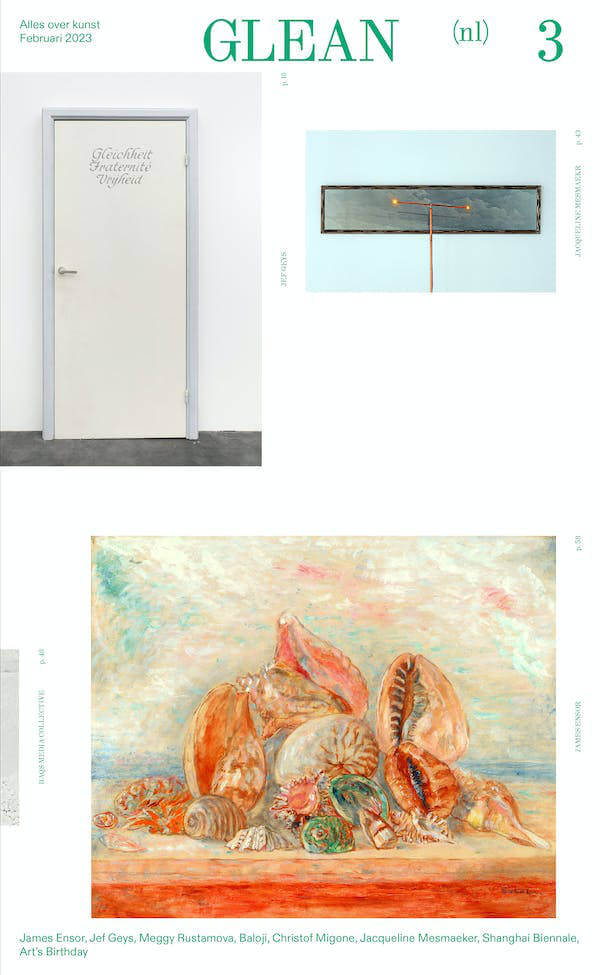
GLEAN - Issue 3 (NL edition)
De derde Nederlandstalige GLEAN editie.
Bijdrages over James Ensor, Jef Geys, Meggy Rustamova, Baloji, Christof Migone, Jacqueline Mesmaeker, Shanghai Biennale, Art's Birthday, en meer.

Teeth Surrounding a Flower in the Meanings
In ‘Teeth Surrounding a Flower in the Meanings’ a compilation of texts from the critical discourse surrounding his work, written by various authors between 2016 and 2023, serves as source material for a series of erasures.
Through retro- and introspectively reading into the works and the practice at large from poetic angles, these poems investigate the relation between art and its discourse, the words used, and their edges.
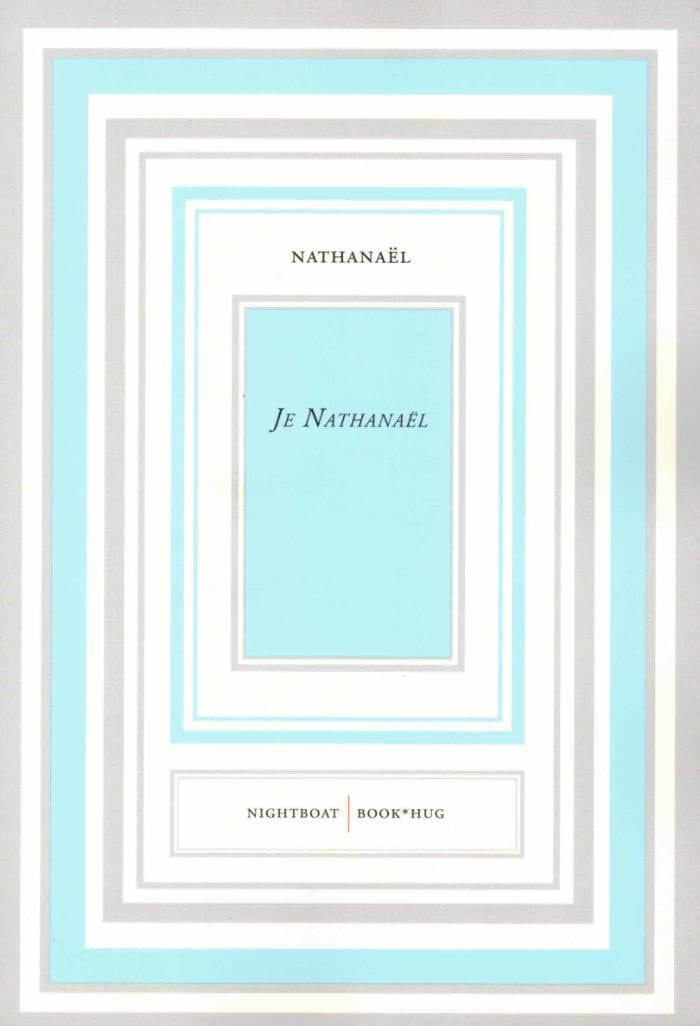
Je Nathanael
In Je Nathanaël, first published in 2006, Nathanaël explores ways in which language constrains the body, shackles it to gender, and proposes instead a different way of reading, where words are hermaphroditic and transform desire in turn. Suggesting that one body conceals another, it lends an ear to this other body and delights in the anxiety it provokes. With parts written in French, other parts in English, this is truly a hybrid text, throwing itself into question as it acts upon itself in translation. It is both originator and recipient of its own echo. In this regard it does not, cannot exist, pulling insistently away from itself in an attempt to draw attention to the very things it seeks to conceal. In this way, Je Nathanaël is a book of paradox, negating itself as it comes into being.

On the Table 6 – The Meal – A Conversation with Gilbert & George
Gilbert & George, Charlotte Birnbaum
Charlotte Birnbaum meets with Gilbert & George to discuss The Meal—a culinary performance organized in 1969 by the British duo, with David Hockney as the guest of honor. Also included here are photos and memorabilia from the singular event (the sixth publication in the On the Table series, that explore the encounter between food and art).
Gilbert & George never cook and always eat out. Back in 1969, however, the artist duo hosted The Meal, an elaborate dinner party that included thirteen guests, Princess Margaret's butler, a chef who prepared a meal from a Victorian cookery manual, and the guest of honor, artist David Hockney. While the art world of the time was largely characterized by Pop art, Minimalism, and Conceptual art, Gilbert & George developed an entirely unique philosophy and combined their daily lives with their artistic vision; in short, their art and life are one! Charlotte Birnbaum took a trip to London's East End to visit the immaculately dressed pair to discuss The Meal and other curious projects from their fifty-year collaboration. Also included here are photos and memorabilia from the singular event.

Walking loaves
An artist book by Luca Trevisani, overwriting in the mode of a palimpsest Piero Camporesi's Bread of Dreams, an Italian cult classic of "food" anthropology.
Walking loaves is a cannibalization of and tribute to Bread of Dreams, the masterpiece by Italian philologist, anthropologist, and literary critic Piero Camporesi. Originally published in 1980, Bread of Dreams is a book about bread as a cultural entity, about the baking practices and the rituals of the humans we have been, and the way we used to feed ourselves.
Seeking to crystallize in his sculptures the act of walking and the metamorphosis of the body, Luca Trevisani has dedicated several shoemaking exercises to bread—emphasized as a collective glue, material history, and biological writing.
After three years of plastic and editorial research on bread, Trevisani pays homage to Camporesi, grafting images of his works and handwritten notes onto its anastatic replica: a mutation grew in the crevices of another book with a gentle-aggressive gesture.
Luca Trevisani (born 1979 in Verona, lives and works in Berlin and Bologna) is one of the young Italian artists who came to prominence at the international level. His research ranges between sculpture and video, and cross border disciplines such as performing arts, graphics, design, cinema of research or architecture.

At the kitchen table
An exhibition guide for a multi-part show conceived by Reliable Copy in India, featuring a range of cookbooks, videos, and artworks around food, by a strong grouping of practices.
Approaching curatorial practice from the perspective of publishing, At the kitchen table looks at how food has historically been—and continues to be—inscribed through various conventional formats, as well as the channels and platforms by which it continues to circulate as material, trace, memory, and culture. Imagined as a show of documents, the exhibition brings together a selection of cookbooks, video works, and artworks.
The selection of cookbooks feature recipes and narratives compiled from artists and art-spaces, anthologies of recipes from literary fiction, cookbooks that function as historical records, and some that are self-published by individuals or community groups. The video works highlight and examine the well-worn format of the instructional cooking class and its associated performativity. Meanwhile, the artworks, which are presented via peripheral, referential, or stand-in documents, respond to (and often assume) the forms of the marketed consumable product, the stand-alone restaurant, the family archive, the recipe book, the menu, the assembly, and the feast.
The proposal, the script, the poster, the photographic documentation, the resource list, the newsletter, the Keynote presentation, and the audio recording—elements that are traditionally left out of the work's exhibition display, but that are often included in catalogues, monographs, or other publications around the work—become stand-ins for the artworks conceptually on display. Through this introduction of artworks via the documents that surround, engender, and represent them, the exhibition seeks to collapse the space between the exhibition and its documentation, the library and the gallery, and the event and its eventual publication.
At the kitchen table is imagined as a travelling, multi-part exhibition that will expand through its responses to the contexts, sites, and venues of its iterations, including those of a publication.
Works by Candice Lin, Carolyn Lazard, Chinar Shah & Nihaal Faizal, David Robbins, Fazal Rizvi, Gavati, Jason Hirata, Lantian Xie, Leone Contini, nonfood, Pushpamala N, Rajyashri Goody, Rasheed Araeen.
Books by Abby Lloyd, Archana Pidathala, Enid Blyton, Esther David, Felicity Dahl & Josie Fison, Filippo Tommaso Marinetti, Happy Potato Press, Mrinalini Bordawekar, Norah M. Titley, S. Meenakshi Ammal, Salvador Dali, Studio Olafur Eliasson, Suresh Jayaram.

Human Pelvis, Bitter Radish
This publication features a project by Leone Contini looking into the canned food available during the war of Caporetto in 1917 and especially its iconography. It brings together an essay by the artist along with reproductions of a selection of his drawings.
Leone Contini (born 1976 in Florence) studied philosophy and cultural anthropology at the University of Siena. His research unrolls at the intersection of anthropology, aesthetics and politics and his mediums include lecture-performances, collective interventions in public spaces, textual and visual narratives, drawings. His research is focused on intercultural frictions, conflict and power relations, displacement, migrations and diasporas, aiming to investigate, to question and to re-shape identity patterns and power relations.

The 1Shanthiroad Cookbook
The 1Shanthiroad Cookbook brings together a collection of recipes from the community kitchen of 1Shanthiroad Studio/Gallery, compiled and edited by the space's founding director, Suresh Jayaram.
Featuring recipes from over 70 contributors, including artists, curators, patrons, residents, and the extended family of friends of 1Shanthiroad, the cookbook serves as a portrait of an evolving cultural community. Emerging from and responding to the history and legacy of 1Shanthiroad - Bangalore's oldest running non-profit residency and arts space - the cookbook frames the kitchen as integral to the site and function of the space, mapping recipes across generations, cultures, and timelines, while anchoring itself in the cultural history of the wider city.
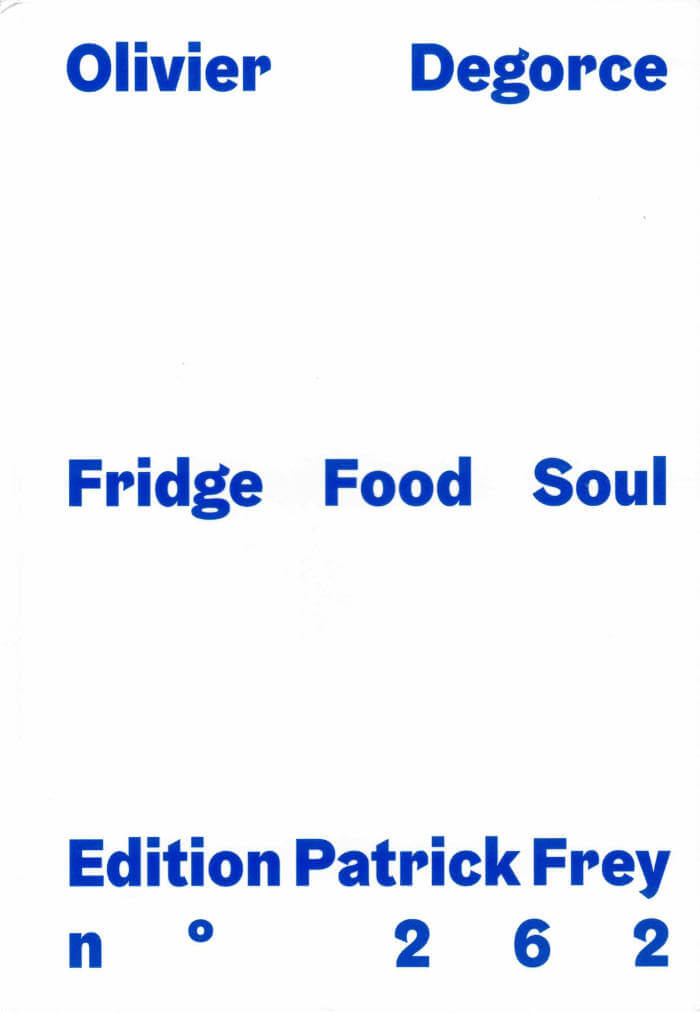
Fridge Food Soul
Photographer Olivier Degorce brings together a series of fridge photographs shot from 1993 to 2017: Beyond the obsessive nature of the project lies the sheer diversity of individual eating habits in the form of contemporary still lifes.
The photographs presented in Fridge Food Soul were shot from 1993 to 2017, for the most part on the spur of the moment, using all sorts of analog and digital devices ranging from the most sophisticated to the most rudimentary cameras. In most cases he took only one shot of each fridge. The serial collection of these snapshots in a single book testifies to the systematic, even obsessive, nature of this project.

De quelques événements sans signification à reconstituer
This book presents Léa Morin's research into the first, long forgotten film by Moroccan filmmaker Mostafa Derkaoui, About Some Meaningless Events (1974), which led to its recent restoration and international distribution. Far from being confined to a cinematographic history, this "book-archive, book-inquiry, book-action" sketches out, from the multiple paths opened up by the film, a constellation of micro-histories on the cultural, artistic and political Morocco/Casablanca of the 1970s.
The book includes a DVD with the film.
Mostafa Derkaoui is a filmmaker and pioneer of modern Moroccan cinema, born in 1944 in Oujda, Morocco. He graduated from the Lódź Cinema School and lives in Casablanca.
Since returning to Morocco in 1972, he has continued the explorations he began in the student films he made in Poland, for a free and socially-engaged cinema that could contribute to both decolonial thought and the search for a Moroccan cinematic identity, and which would also encourage formal innovation and radicality.His avant-gardist vision was to come up against the official and repressive one of the 1970s Moroccan state (and of the remaining colonial institutions). His first film, De quelques événements sans signification [About Some Meaningless Events, 1974], made with a collective of Casablancan artists and intellectuals, was banned. It was later restored by the Filmoteca de Catalunya and L'Observatoire Art et Recherche in 2019.
Edited by Léa Morin.
Preface by Mostafa Derkaoui.
Texts by Ahmed Boughaba, Nadir Bouhmouch, Tarek Elhaik, Ali Essafi, Filmoteca de Catalunya (Rosa Cardona, Mariona Bruzzo et Esteve Riambau), Mohamed Jibril, Toni Maraini, Léa Morin, Mostafa Nissabouri, Marie Pierre-Bouthier, Noureddine Saïl, Rasha Salti et Monika Talarczyk.

Poster Photo Magazine #01
The first issue of the biannual magazine offering an heterogeneous and multifaceted exploration of approaches to modern and contemporary photography through 12 large-format wall posters, folded and detachable, with Julia Andréone, Roman Cieslewicz, Marie Quéau, Stig De Block, Area Of Work, Aurélien Froment, Fabio Mauri, Thomas Demand, Marie Deteneuille, Simon Menner, Kuba Ryniewicz, and Deborah Turbeville.

Working Title
An overview of Phill Niblock's work since the 60's, through about twenty essays and interviews by musicologists, art critics and historians, various documents, scores, and more than 8 hours of videos on 2 double layer DVDs.
With a career spanning more than 40 years, Phill Niblock has not only proven himself as one of the most preeminent composers of the American musical avantgarde, but also an accomplished filmmaker and performer. He is also revered as an events producer through his Experimental Intermedia Foundation, providing a venue and a label that has been of great assistance to numerous other artists and musicians in helping to make their work known.
This bilingual book (French / English) provides an in-depth look at all these activities, through various essays and interviews, either newly written, previously unpublished, or that have never been available in French before. These were written by very different people—from musicians who have played Niblock's music, to fellow composers, from long-time friends to specialized musicologists and art historians. They discuss such various matters as musical and cinematographic aesthetics, psychoacoustic processes, historical background, philosophical insights and technical advice for playing the music, or just give their personal recollections of time spent together with Niblock.
The book is accompanied by 2 double-sided DVDs of atypical videos: Remo Osaka, a continuation of The Movement of People Working series, with a quite peculiar soundtrack; two separate DVDs of the Anecdotes from Childhood, best viewed together as an installation; and Katherine Liberovskaya's 70 for 70 (+1), Seventy (one) Sides of Phill Niblock, realized in 2003/2004 on the occasion of his 70th birthday, which portrays the composer through memories recounted by friends and relatives.
With writings by Phill Niblock, Rich Housh, Erika King, Guy de Bièvre, Volker Straebel, Richard Glover, Alan Licht, Seth Nehil, Rob Forman, Johannes Knesl, Arthur Stidfole, Juan Carlos Kase, Raphael Smarzoch, Jens Brand, Bob Gilmore, Ulrich Krieger, Richard Lainhart, Bernard Gendron, Susan Stenger, Mathieu Copeland, and liner notes from the first two LPs.
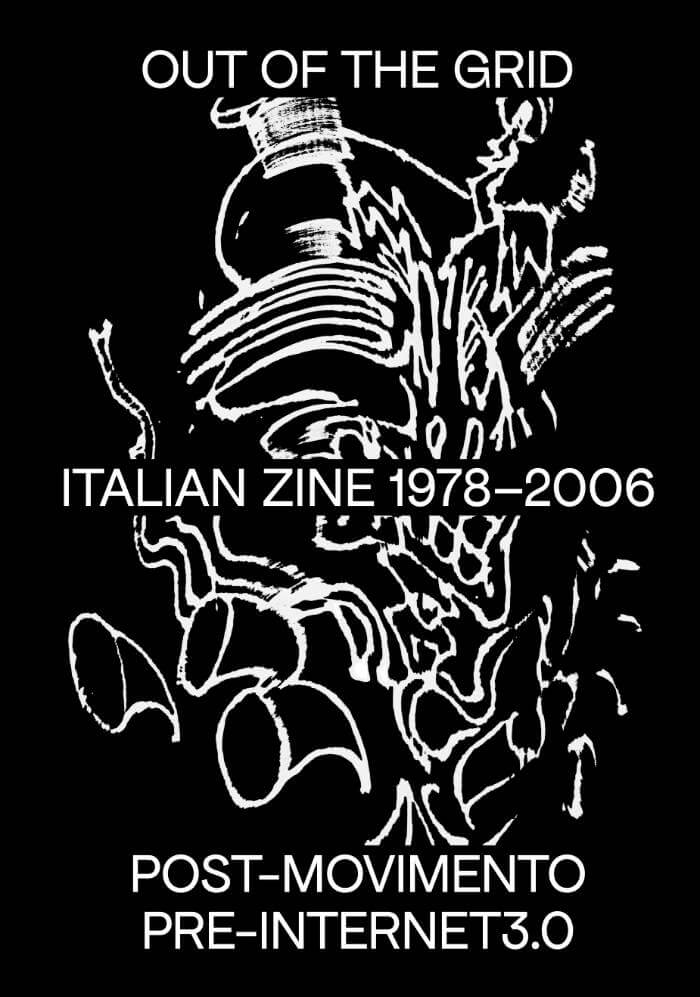
Out of the Grid – Italian Zine 1978-2006
Dafne Boggeri, Sara Serighelli
Out of the Grid presents a critical selection of 100 Italian zines from 1978 to 2006 that display a broad spectrum of social, political, aesthetic, and technological changes in the use of language and communication strategies across the territory of self publishing.
Widely mapping Italian society, particularly youth culture—over an extended period that can be symbolically defined as the "post-movement" and "pre-internet3.0"—, this outpouring of creativity gave visibility to small, imaginative and technical shifts on paper that made mimeographs, photocopiers and offset machines tremble, and often erupted into the need to communicate through other mediums. The titles selected originated from different scenes—musical, social, artistic, literary...—within which the distances between authors and readers is eliminated. To help navigate this multitude of subcultures, each zine is introduced by a profile that provides further analysis and information. No specific structure has been imposed, leaving room for the specific characteristics of each project to emerge. 100 titles ∞ paths.
Contribution by Marta Zanoni; interviews with Dafne Boggeri, Gino Gianuizzi, Stefano Gilardino, Glezös, Fabiola Naldi, Lorenza Pignatti, Pietro Rivasi, Giulia Vallicelli [Compulsive Archive].
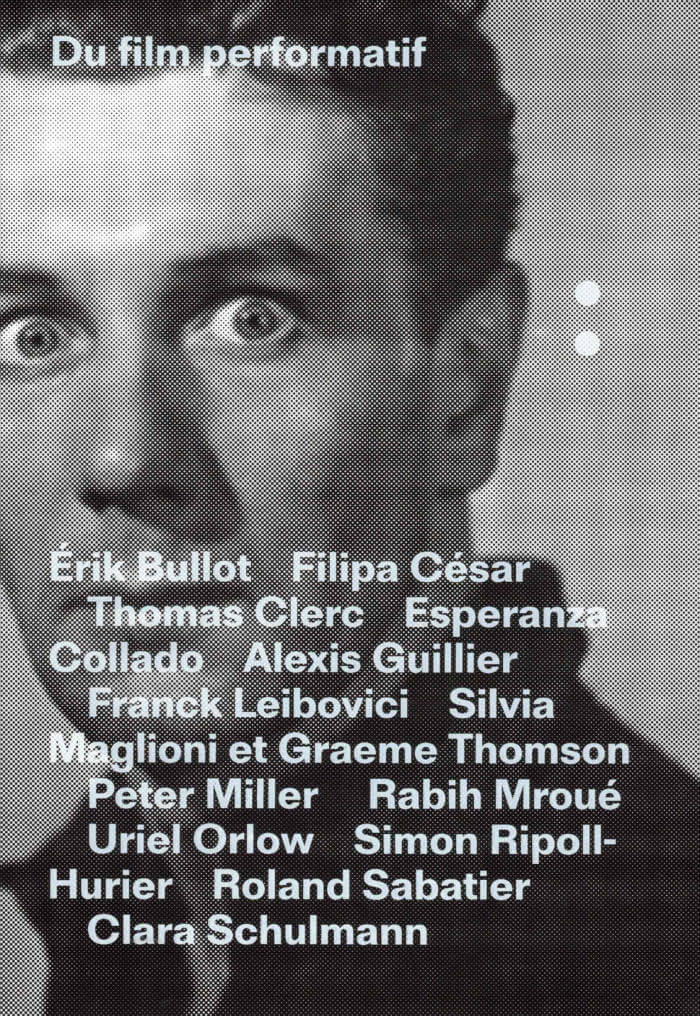
Du film performatif
Mapping the practices of performative cinema today.
Texts by Érik Bullot, Filipa César, Esperanza Collado, Thomas Clerc, Alexis Guillier, Franck Leibovici, Silvia Maglioni & Graeme Thomson, Peter Miller, Rabih Mroué, Uriel Orlow, Simon Ripoll-Hurier, Roland Sabatier, Clara Schulmann.

Feminist Takes – “Early Works” by Želimir Žilnik
The prospects of revolutionary feminism, from Želimir Žilnik's canonical film.
Canonical within the Yugoslav New Film of the late 1960s and the 1970s, Želimir Žilnik's Early Works (1968) follows the female revolutionary Jugoslava as she leaves her lumpenproletariat family to spread the teachings of young Marx and Engels among the peasants and factory workers. The violent responses to this proselytizing mission, which include the rape of Jugoslava and the beating of her three male comrades, invoke the repression of the 1968 student movement in socialist Yugoslavia. The film's allegorical examination of the contradictions of Yugoslav state socialism culminates when Jugoslava becomes the object of her comrades' violence, who shoot her and set her body on fire.
This edited volume, a part of Antonia Majaca's ongoing collaborative investigation Feminist Takes, initiates a discussion of the filmic—and historical—fate of Jugoslava and the prospects of revolutionary feminism.
From his beginnings in the lively amateur film scene of Yugoslavia in the 1960s, filmmaker Želimir Žilnik (born 1942, based in Novi Sad, Serbia) has gone on to make more than fifty films, including a number of feature films and TV productions, often in the genre of docudrama. He received international recognition early on, winning the Golden Bear for Best Film at the 1969 Berlin International Film Festival for Early Works. In the 1970s his films encountered political opposition, and he left Yugoslavia for West Germany, where he realized several independent films, including some of the earliest films dealing with the topic of guest workers. In the 1980s, after leaving Germany—due to his films once again facing political opposition and censorship—and returning to Yugoslavia, he made numerous TV and feature films through which he portrayed early symptoms of the country's growing social conflicts, continuing in the 1990s with films dealing with the maladies of the post-socialist transition as well as questions of migration.
Edited by Antonia Majaca, Rachel O'Reilly, Jelena Vesić.
Texts by Ivana Bago, Angela Dimitrakaki, Branislav Dimitrijević, Irmgard Emmelhainz, Rose-Anne Gush, Vesna Kesić, Vedrana Madžar, Antonia Majaca, Jaleh Mansoor, Ruth Noack, Bojana Pejić, Ana Teixeira Pinto, Rasha Salti, Kerstin Stakemeier, Jelena Vesić, Giovanna Zapperi.

Politically Red
Sara Nadal-Melsio, Eduardo Cadava
How reading and writing are collective acts of political pedagogy, and why the struggle for change must begin at the level of the sentence.
"Reading is class struggle," writes Bertolt Brecht. Politically Red contextualizes contemporary demands for social and racial justice by exploring the shifting relations between politics and literacy.
Through a series of creative readings of Karl Marx, Rosa Luxemburg, Walter Benjamin, W. E. B. Du Bois, Fredric Jameson, and others, it casts light on history as an accumulation of violence and, in doing so, suggests that it can become a crucial resource for confronting the present insurgence of inequality, racism, and fascism. Reading between the lines, as it were, and even behind them, Cadava and Nadal-Melsió engage in an inventive mode of activist writing to argue that reading and writing are never solitary tasks, but always collaborative and collective, and able to revitalize our shared political imagination.
Drawing on what they call a "red common-wealth"—an archive of vast resources for doing political work and, in particular, anti-racist work—they demonstrate that sentences, as dynamic repositories of social relations, are historical and political events.

The Singularity
The Singularity is a study of grief, migration, and motherhood from one of Sweden's most exciting new novelists.
In an unnamed coastal city filled with refugees, the mother of a displaced family calls out her daughter's name as she wanders the cliffside road where the child once worked. The mother searches and searches until, spent from grief, she throws herself into the sea, leaving her other children behind. Bearing witness to the suicide is another womanon a business trip, with a swollen belly that later gives birth to a stillborn baby. In the wake of her pain, the second woman remembers other losses—of a language, a country, an identity—when once, her family fled a distant war.

GLEAN - Issue 2 (NL edition)
De tweede Nederlandstalige GLEAN editie.
Jan Van Imschoot – Painting with a Vengeance
Jan Van Imschoot was tien jaar oud toen hij voor het eerst naar het Lam Gods van Jan van Eyck ging kijken. Tot op vandaag laat het schilderij hem niet los. ‘Het is de moeder van alle meesterwerken. Niemand heeft het ooit echt kunnen vatten, zelfs als je daar een heel leven aan zou wijden blijft het een mysterieus werk.’ Kathleen Weyts sprak met de schilder naar aanleiding van zijn grote overzichtstentoonstelling in het S.M.A.K.
Aay Liparoto – Small Acts of Violence
Wat gebeurt er als liefde gepaard gaat met fysiek of verbaal geweld? Wat als we zelf degene zijn die gewelddadig zijn? Herkennen we onszelf als dader? En hoe verhouden liefde en geweld zich tot een gevoel van veiligheid? Aay Liparoto’s filmische VR-ervaring in argos, Small Acts of Violence, verkent de verstrengeling van liefde, onvrijwillig fysiek geweld en zelfverwonding in intieme en familierelaties. Bas Blaasse ging met hun in gesprek.
Dorothy Iannone – Alles op Venus
De tentoonstelling Love Is Forever, Isn’t It? in het M HKA extraheert een overzicht uit het rijke en gelaagde oeuvre van Dorothy Iannone. Haar oeuvre heeft onmiskenbaar een narratief karakter: duizenden woorden, zinnen, alinea’s, brieven en teksten krioelen kleurrijk doorheen de zalen van het museum. Het is onmogelijk om alles te lezen, laat staan alle narratieven mee te krijgen. Maar alle aspecten van Iannone’s kunst komen aan bod en leven naast elkaar in een niet-lineair verhaal. Dagmar Dirkx bespreekt de expo.
Voorbij de leegte van de woestijn
Wolfram Vandenbergen en Frederik Thys bespreken de expo Performing Colonial Toxicity die momenteel loopt bij Framer Framed in Amsterdam. Architectuurhistorica Samia Henni construeert een alternatief archief voor de amper gekende nucleaire bladzijde uit de koloniale geschiedenis van Algerije. Een alternatief archief, want hoewel officiële documenten over het koloniale nucleaire programma in Algerije bestaan, houdt de Franse overheid ze vooralsnog achter slot en grendel.
Boeken
In onze maandelijkse boekenrubriek licht Els Roelandt twee recente boeken uit: The Uncanny van de als documentair fotograaf opgeleide Léonard Pongo, en Bring No Clothes: Bloomsbury and the Philosophy of Fashion door Charlie Porter. Door de vele zwart-witfoto’s van de Bloomsbury Group zouden we haast vergeten dat de leden ervan met regelmaat in uitbundige kleuren gekleed gingen, en bovendien zelf graag hun eigen kleren maakten en repareerden. Zo werd handwerk een filosofie en een manier van in het leven staan, een boodschap waarin Porter troost, comfort en geluk vindt.
Verder in november
Naar aanleiding van hun 25-jarig bestaan gaat Tamara Beheydt in gesprek met de coördinator van NICC, Anyuta Wiazemsky Snauwaert. Isabelle De Baets spreekt met de Nederlandse kunstenaar, toekomstdenker en schrijver Louwrien Wijers. Barbara De Coninck bezoekt kunstverzamelaar Walter Vanhaerents, de man achter de Vanhaerents Art Collection. We bespreken de performance Swallow Me Whole van Flora Van Canneyt en Ans Van Gasse. En uiteraard geven we een royale selectie ‘gleanings’, onze redactionele tips van lopende tentoonstellingen en niet te missen evenementen en happenings. Met onder andere Mashid Mohadjerin en Shervin/e Sheikh Rezaei bij Cc Strombeek, Hélène Amouzou en Nicole Eisenman in Londen, twee expo’s in Berlijn, en in Brussel de groepstentoonstelling Connecting bij KANAL, Laurent Dupont bij Gauli Zitter, Léon Wuidar bij Rodolphe Janssen en Mariana Castillo Deball bij Mendes Wood DM.

GLEAN - Issue 2 (ENG edition)
Striking a balance between lightness and seriousness, this Winter Issue of GLEAN offers plenty of in-depth reflection as well as a glimpse of what lies around the corner.
Guest Editor: Oscar Murillo
For each issue, GLEAN invites a Guest Editor to curate a section of the magazine. We interview them and ask them to invite three writers or artists who have influenced their practice (or who otherwise deserve our attention) to take up space in our pages. Oscar Murillo (1986, La Paila, Colombia) lives and works between London, La Paila and (since recently) Brussels. On the occasion of his first solo show at WIELS in Brussels, titled ‘Masses’, which opens in February 2024, we asked him to serve as Guest Editor for our Winter Issue. Murillo asked curator and researcher Renan Laru-an and writer and producer Anna T. Pigott to contribute texts. Artist and writer Rene Matic provided a visual contribution.
Studio Visit: Che Go Eun
Finding an affordable and suitable studio space is perhaps one of the greatest challenges a young artist faces. Not only does there seem to be a shortage of adequate infrastructure in densely populated cities such as Antwerp or Brussels, but the rental prices are also very high. Level Five VZW is an artist cooperative managing several studio spaces in Brussels. Tamara Beheydt visited artist Che Go Eun in her shared studio space at Level Five’s location next to WIELS Contemporary Art Centre.
The Artist’s Library
Each issue, Els Roelandt delves into the personal library of an artist for the Artist’s Library – a column celebrating books and their writers, editors, publishers, designers and readers. For this month’s contribution, she visited Olivia Plender in Stockholm on a dark afternoon in November. The two browsed and discussed Plender’s impressive library, which contains many titles related to plants, feminism and books by and on women who are carrying on the struggle to dismantle patriarchal structures.
Hana Miletic
Having transitioned from a kind of street photography to weaving, Hana Miletic embraces the act of reproduction. Her work with textiles has evolved into an embodied and social practice. Miletic contributed the cover images for this Winter Issue, which are also being printed as a limited GLEAN artist’s edition. María Inés Rodríguez, director of the Walter Leblanc Foundation in Brussels, met up with the artist, who is gearing up for a busy season. Miletic’s work is on view in no fewer than four group shows across Europe and her first solo exhibition in the US will open next spring.

Pages 8 - When Historical
Nasrin Tabatabai, Babak Afrassiabi
What determines our place in history? If it is the past, there we also find the material support with which we reconstitute our historical place. Our relation to history remains retrospective, but also anticipatory.
Events begin with a break from history. But they soon are recaptured by it and fetishized as historical triumphs or failures. Still something remains of past events that, although conditioned by history, is irreducible to it: a surplus that finds way to our time, something out of time that forces us to actively anticipate a renewing in past events.
With contributions by:
- Dariush Moaven Doust / Machinic Life
- Alireza Rasoulinejad & Saleh Najafi / Minor/Major [conversation]
- Norman Klein / Imaginary Future and the Archive [interview]
- Gerald Raunig & Roberto Nigro / Molecular Revolution and Event
- Saleh Najafi / Hope Against Hope
- Sven Augustijnen / Coincidences of History: Reflections on E'mile Meurice's 'Sketch for a psychologial study of Leopold II'
- Jalil Ziapour, Houshang Irani, Gholam Hossein Gharib / Excerpt from Khoroos Jangi magazine, 1949-50
- Performance in Iran [conversation] with Neda Razavipour, Jinoos Taghizadeh, Shahab Fotouhi, Bavand Behpour, Amir Mobed and Mahmoud Bakhshi
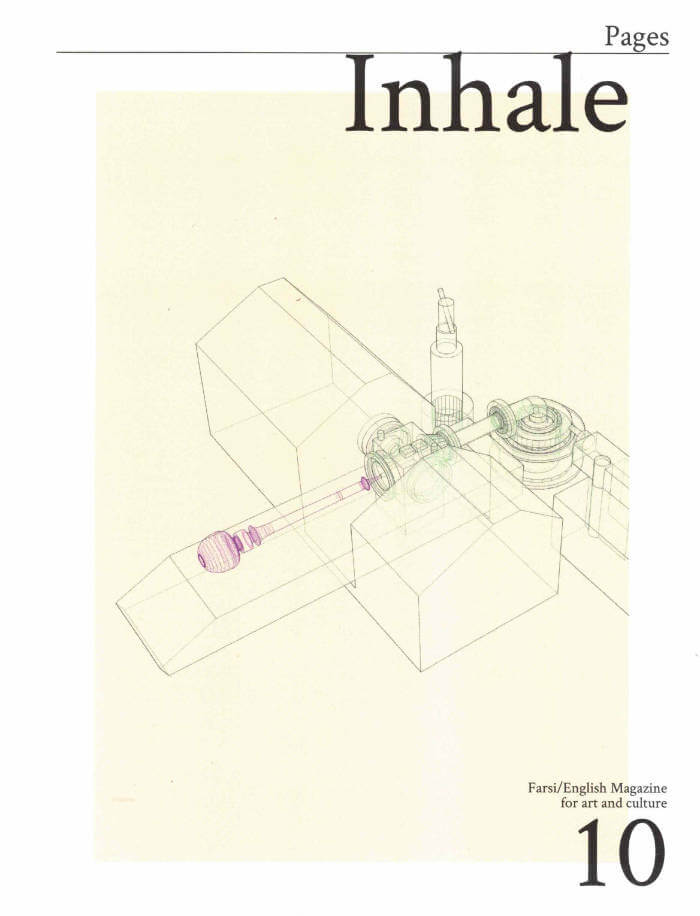
Pages 10 - Inhale
Nasrin Tabatabai, Babak Afrassiabi
The theme of this issue of Pages was triggered by the idea of opium smoke as a ‘writing machine.’ Since the early opium trade, there has been writing not only on opium, but also through opium, especially in countries linked to past and present drug networks. In this issue we are tapping into the deeply rooted relationship between writing and drugs, especially beyond the Western literary tradition, and wondering about the current conceptual and material derivatives of intoxication with which we can machinate new extremities in our chemical, historical and technological relations to the world.
With contributions by:
- Jason Bahbak Mohaghegh / Smoke, Drug, Poison: A Philosophy of the Faramoosh-Khaneh (Opium Den)
- Pages / Dissolving, Mixing, Melting, Stirring (the Smoke)
- Hung-Bin Hsu / The Taste of Opium: Science, Monopoly and the Japanese Colonization in Taiwan, 1895—1945
- Saleh Najafi / Hedayat: The Opium of Translation and Creating the Impossible Memory
- Patricia Reed / The Toxicity of Continuity
- Fuko Mineta / A Monster Appears in Qingtian
- Morad Farhadpour / Inside and Outside Addiction
- Mohammad-Ali Rahebi / Of Junk and Time: Trauma, Habit, Capitalism

Pages 9 - Seep
Babak Afrassiabi, Nasrin Tabatabai
This issue of Pages assumes seep as a post archival mode: in the Merriam-Webster dictionary the verb 'seep' is translated as follows: to flow or pass slowly through fine pores or small openings, to enter or penetrate slowly, to become diffused or spread.
The biology or politics of seeping is like that of raw petroleum oozing at natural oil seeps. Unlike refined oil which has sponsored modernization and its aligned archives, crude oil pours beyond historical purpose and defies structural elevations. It instead disfigures the ground through which it dubiously spreads.
Seeping is a posthumous affair. It is the gradual leaking of a long withdrawn interior. Like the bleeding of a punctured corpse, when the pumping of the heart has stopped, when the body is lifeless and apathetic to any 'hail', yet continuing to bleed. Seep as archive is an eternally post-apocalyptic expansion, retraction, deviation, subtraction, or simply the arrival of (non-)things.
With contributions by:
- Mariam Motamedi Fraser / Geo-Archive
- Richard Goldstein / Dennis Oppenheim's Dilemma: Should he Sell Art to the Shah?
- Babak Afrassiabi, Nasrin Tabatabai / Contemporary Hole / Unfilmable
/ Seep
- Saleh Najafi / Wounds of Archive¹
- Mark von Schlegell / The Artist Abstract #6
- Nima Parzham / The underground
- Adam Kleinman / Vanished Theories
- Suzanne Treister / Algorithm
- Alexi Kukuljevic / The Dissolute Subject
- Matts Leiderstam / Andy Warhol, Suicide (Purple Jumping Man), 1963
- Eugene Thacker / Black Infinity; or, Oil Discovers Humans
- Vivian Ziherl, Natasha Ginwala / Infrastructural Suspensions: Global Spanning, Atmospheric Seepage and Measures of the Undecidable

A take away cup and a cloud
A take away cup and a cloud is an essay written alongside the dance performance Seems to be by Denise Lim and Stina Ehn. It plays with a variety of containers–the list form being one. By mixing a personal with a historical gaze it traces the trajectory of mundane commodities and the replacement of material with imaterial objects brought about to the everyday by technical progress.
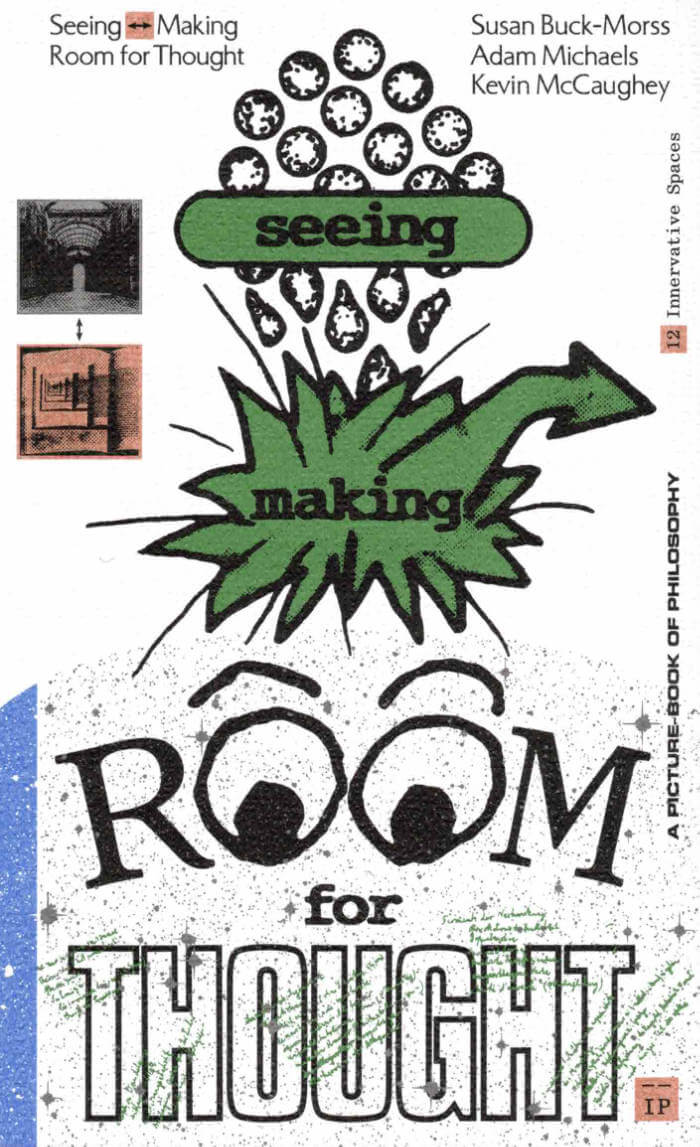
Seeing Making: Room for Thought
Adam Michaels, Kevin McCaughey and 1 more
Seeing <―> Making: Room for Thought both studies and presents the creative process of constructing ideas with images. By activating the techniques of montage, the book reveals a wide field of view and a space to engage new critical connection between a multiplicity of objects from the past and present. Realized through an intergenerational collaboration of three cultural producers committed to making theory visible, a transformative anthology of critical essays by Susan Buck-Morss anchors this kaleidoscopic project. Images and ideas sync with Buck-Morss’ perceptive texts on visual culture, history, politics, and aesthetics, fusing criticism with visual play and linking collective imagination and social action.
Building upon the methods and ways of seeing put forth by visual thinkers like Walter Benjamin and John Berger, designer Kevin McCaughey (Boot Boyz Biz), designer, editor, and publisher Adam Michaels (IN-FO.CO/Inventory Press), and renowned theorist Buck-Morss collectively assemble colliding material into new relation. What results is a (typo-) graphic articulation that thinks seriously about the stakes of ideation and reorients the space of the book in the service of a theory and philosophy that speaks the language of our image-based information age.